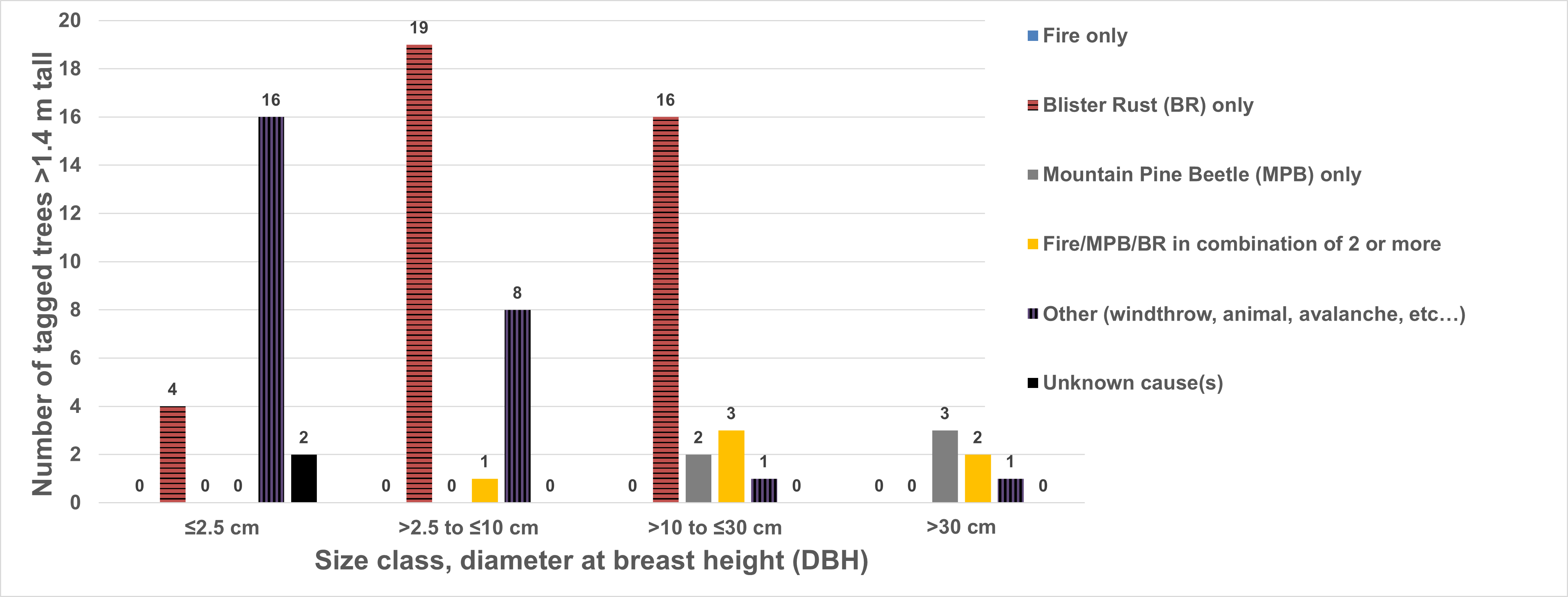Part of a series of articles titled Whitebark Pine Monitoring in the Greater Yellowstone Ecosystem.
Article
Whitebark Pine Mortality in the Greater Yellowstone Ecosystem – Data Summary of Monitoring in 2023

NPS
This is the third article in the article series, Whitebark Pine Monitoring in the Greater Yellowstone Ecosystem.
Articles 2 to 4 of this article series summarize data from Panel 4 transects surveyed between June and September 2023. This is the fourth revisit to these 44 transects for full survey data collection (see Figure 3 in Article 5—Methods—for the panel sampling revisit schedule).
This article presents results for Objective 3 in the Interagency Whitebark Pine Monitoring Protocol for the Greater Yellowstone Ecosystem.
Objective 3 - Estimate survival of individual whitebark pine trees (Pinus albicaulis) more than 1.4 meters (>1.4 m) tall, explicitly accounting for the effects of white pine blister rust (Cronartium ribicola) infection, mountain pine beetle activity, and wildfire.
Overview of Methods
(For detailed methods, see Article 5 and the monitoring protocol.)
All trees in the tagged population (>1.4 m tall) within the 10 meter wide by 50 meter long (10 × 50 m) boundary of each transect were recorded as live or dead. For live trees, we recorded evidence of blister rust infection, mountain pine beetle attack (pitch tubes, frass), impact from fire, or other mortality influencing factors, such as windfall or avalanche. For dead trees we recorded any J-shaped galleries under the bark from mountain pine beetle activity.
Note that data summaries from transects surveyed in any given year do not reflect the entire sample of transects; therefore, they do not represent the overall Greater Yellowstone Ecosystem population of whitebark pine and should not be used to draw wide-reaching conclusions about status or trends.
Results for Objective 3—Mortality
In 2023, we observed 78 newly dead tagged trees on Panel 4 transects (Figure 1). Of these, 22 (28%) were ≤2.5 cm DBH, 28 (36%) were >2.5 to ≤10 cm DBH, 22 (28%) were >10 to ≤30 cm DBH, and 6 (8%) were >30 cm DBH. Thirty-nine (50%) of the dead trees had evidence of blister rust infection from one or more previous surveys but no evidence of mountain pine beetle or fire effects. Evidence of mountain pine beetle infestation only was found in 5 (6%) of the dead trees (2 were >10 to ≤30 cm DBH, and 3 (4%) were >30 cm DBH). Six dead trees (8%; 1 in the >2.5 to ≤10 cm DBH category, 3 in the >10 to ≤30 cm DBH category, and 2 in the >30 cm DBH category) had signs of a combination of blister rust, mountain pine beetle, and/or fire. Other health impacts (e.g., windthrow, animal damage, mechanical damage, avalanche) were documented for 26 (33%) of the dead trees, while the remaining 2 (3%) died of unknown causes. Twenty (26%) of the dead trees had previously been recorded with evidence of cone production. Four Panel 4 transects no longer had live, tagged trees, but two of these were documented with five-needle pine regeneration (trees ≤1.4 m tall). Three of these transects experienced stand replacing burns: one burned in the 2012 Dewdrop Fire in Yellowstone National Park, and two burned in the Millie Fire of 2012 on the Custer-Gallatin National Forest. The fourth transect with no live trees was located in an avalanche chute that uprooted live, tagged trees over several years until none remained.

NPS
Learn More
This web article will be updated regularly with new results, but the 2023 results presented here are summarized in a resource brief for 2023. For more results from past years please visit the Greater Yellowstone Network website.
- Duration:
- 13.146 seconds
Mountain pine beetle hindered from entering a boring hole in this whitebark pine. The tree exudes sap - a pitch tube - to fend off attacking beetles.
Last updated: June 25, 2024
